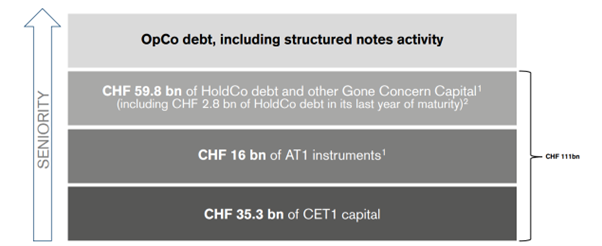

On Sunday night [19 March], Swiss regulators wrote down Credit Suisse’s AT1 securities to zero. Debt investors are in uproar; not because they lost money, but because the rules were changed.
What is an Additional Tier 1? Additional Tier 1s (AT1s) are a type of hybrid debt instrument which qualify as capital because they can absorb losses and maintain a bank’s solvency during periods of financial stress. The bonds are perpetual, but include call options no less than five years after issue.
How do AT1s absorb losses? In order to absorb losses during a period of stress, AT1s include triggers which, once exercised, either result in their conversion to equity or write-down to zero. These triggers include a:
- Capital trigger: This is connected with the bank’s capital ratio, and must be exercised if that ratio falls below either 5.125% or 7%. Credit Suisse had AT1s referencing both capital levels.
- Viability trigger: This is exercised at the discretion of the regulator. The regulator’s decision-making process is not clear, but if they determine the bank to no longer be viable, they must inform them that all subordinated instruments will be written down to zero.
AT1s are part of a group of bank capital securities known as contingent convertibles (Cocos). These can be converted from bonds into equity, or written down entirely, contingent on these triggers being exercised.
When do AT1s absorb losses? According to the creditor hierarchy introduced with the creation of new regulatory capital frameworks following the global financial crisis (2008), AT1s absorb losses only after common equity has been completely drained.
Regulators and banks, across Europe and even within Switzerland, have vigorously stressed the importance of this hierarchy, as illustrated by Credit Suisse in the chart below – notice the big ‘Seniority’ arrow on the left-hand side.
Source: Credit Suisse, as of 31 December 2022. 1. The above numbers detail the notional value of the relevant debt instruments which may differ from the present value of the instruments. 2. HoldCo debt with a remaining final maturity of under a year do not qualify as Gone Concern Capital but remain bail-in eligible and junior to OpCo debt (including structured notes activity.
Was this not the case on Sunday? No. The accepted and agreed creditor hierarchy, outlined above, was ignored. UBS’s acquisition of Credit Suisse resulted in equity investors receiving CHF3bn, while AT1s were written down to zero.
Do AT1 terms allow this? Yes. Swiss-issued AT1s include language that allows the write-down of AT1s before equity, but only if a viability or capital trigger is exercised.
So, was the viability trigger exercised? Actually, no. A viability event was not triggered by FINMA, the Swiss regulator. We know this because Credit Suisse’s legacy Tier 2 instrument (6.5% 2023) remains alive and kicking. If a viability event had occurred, the regulator would have had to have written this instrument down to zero, as well as the AT1 (as stated on p11 of the AT1 prospectus).
If there was no viability trigger, was the capital trigger exercised? Again, no. With CHF35bn of common equity and a capital ratio of 14.1% at the end of 2022, this was not a solvency issue for Credit Suisse, and the 7% trigger was nowhere near being invoked.
So, neither trigger was exercised yet the AT1s were still written down? Exactly, and this is the crux of the issue. While AT1 investors were aware of the write-down risks associated with these instruments when investing, the subordination of these bonds to equity investors, especially when no triggers were exercised, is akin to changing the rules during the middle of the game. Others have been less diplomatic.
Why were neither triggered? This was probably because only four days earlier (Wednesday 15 March), the Swiss National Bank, in conjunction with FINMA, had provided Credit Suisse with a CHF50bn liquidity injection following their conclusion that the bank continued to meet “the higher capital and liquidity requirements applicable to systematically important banks”. In plain English, it was solvent.
So, what actually happened? An unprecedented weekend change in the law. At 8.00pm on Sunday night, the Ordinance on Additional Liquidity Assistance Loans and Granting of Federal Default Guarantees for Liquidity Assistance Loans went live. Article 5a of this ordinance referred to AT1s and stated that FINMA had the discretion to write-down AT1 capital once liquidity support, with a default guarantee, had been granted.
Has an AT1 ever been written down before? Yes, in 2017 with Banco Popular, a Spanish bank. This case was, however, different because the Bank of Spain exercised the viability trigger as the bank was deemed insolvent due to weak capital. Therefore, it wrote down the bank’s AT1 and Tier 2 securities to zero, before selling the business to Banco Santander for €1.
Has Sunday’s events set a precedent? No. Monday witnessed coordinated statements from the European Central Bank (ECB), and the Bank of England (BoE) confirming the clear statutory order in which shareholders and creditors of a troubled bank should bear losses. In particular, they stressed that subordinated bond holders will not suffer losses until all common equity instruments have been written down in full. They also noted that AT1s are, and will remain, an important component of the regulatory capital framework.
What next for AT1s? While the events of Sunday were an undoubted shock to the $275bn AT1 universe, it is important not to throw the baby out with the bathwater. We were negative on the asset class until late last year as yields did not remotely compensate for the risk. However, the repricing seen since has improved the risk/reward of these instruments, especially in light of the ECB and BoE comments. As a result, we remain constructive, and will look to selectively add to our fixed income holdings.







